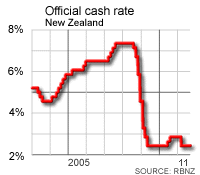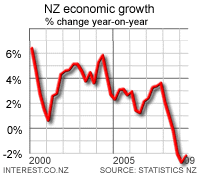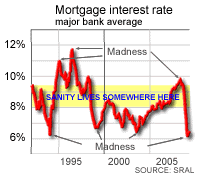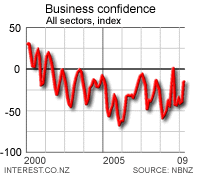 By Rodney Dickens With Jim Carrey and Jeff Daniels in Dumb and Dumber you know that whatever they get up to they will mess it up. They are destined to make mistake after mistake and that is part of what is funny about the movie. By contrast, monetary policy is supposed to be a serious game because it has major impacts on people and therefore one would hope that the brains trust at the Reserve Bank had more commonsense than to repeat the same mistake time and time again. But it seems that NZ monetary policy is destined to follow the lead of Carrey and Daniels. In the one-page statement released on 30 April in support of the RBNZ's decision to cut the OCR 0.5% to 2.5% Governor Bollard said: "Overall, developments since March point to lower medium-term inflation than previously projected." "The main factors behind this are weaker global growth, and an unwarranted tightening in financial conditions via both higher long-term interest rates and a stronger exchange rate than expected." He concluded: "We consider it appropriate to provide further policy stimulus to the economy. We expect to keep the OCR at or below the current level through until the latter part of 2010. The OCR could still move modestly lower over the coming quarters." Consistent with the Governor's views a number of economists/commentators have suggested the rise in the exchange rate is reason for the RBNZ to cut the OCR more. And this would make sense if the higher NZD wasn't justified by prospects for the economy (i.e. if a higher exchange rate would choke off the recovery without further interest rate cuts).
By Rodney Dickens With Jim Carrey and Jeff Daniels in Dumb and Dumber you know that whatever they get up to they will mess it up. They are destined to make mistake after mistake and that is part of what is funny about the movie. By contrast, monetary policy is supposed to be a serious game because it has major impacts on people and therefore one would hope that the brains trust at the Reserve Bank had more commonsense than to repeat the same mistake time and time again. But it seems that NZ monetary policy is destined to follow the lead of Carrey and Daniels. In the one-page statement released on 30 April in support of the RBNZ's decision to cut the OCR 0.5% to 2.5% Governor Bollard said: "Overall, developments since March point to lower medium-term inflation than previously projected." "The main factors behind this are weaker global growth, and an unwarranted tightening in financial conditions via both higher long-term interest rates and a stronger exchange rate than expected." He concluded: "We consider it appropriate to provide further policy stimulus to the economy. We expect to keep the OCR at or below the current level through until the latter part of 2010. The OCR could still move modestly lower over the coming quarters." Consistent with the Governor's views a number of economists/commentators have suggested the rise in the exchange rate is reason for the RBNZ to cut the OCR more. And this would make sense if the higher NZD wasn't justified by prospects for the economy (i.e. if a higher exchange rate would choke off the recovery without further interest rate cuts).
 But there are plenty of historical precedents for believing the forex market has pushed the exchange rate up because it has correctly assessed that NZ growth prospects have improved. The foreign exchange (forex) market has a much better track record than the RBNZ at assessing prospects for the economy which means the RBNZ's puzzling decision to commit to keeping the OCR at or below the current level until the second half of 2010 could well mean Governor Bollard is about to repeat the mistake he made only a few years ago, as well as repeating the mistake his predecessor made a decade earlier. The RBNZ is in part worried about a rising NZD hurting growth but students of NZ's economic history might remember that Governor Brash made the same mistake in the early 1990s. The forex market tends to be much quicker than the RBNZ at picking economic recoveries (and downturns). Look at the experience in the early 1990s when the currency started to rise, which was a vote of confidence in the economy, but the RBNZ allowed interest rates to fall much further which resulted in the economic recovery that followed being much, much stronger than the RBNZ and the economists were predicting.
But there are plenty of historical precedents for believing the forex market has pushed the exchange rate up because it has correctly assessed that NZ growth prospects have improved. The foreign exchange (forex) market has a much better track record than the RBNZ at assessing prospects for the economy which means the RBNZ's puzzling decision to commit to keeping the OCR at or below the current level until the second half of 2010 could well mean Governor Bollard is about to repeat the mistake he made only a few years ago, as well as repeating the mistake his predecessor made a decade earlier. The RBNZ is in part worried about a rising NZD hurting growth but students of NZ's economic history might remember that Governor Brash made the same mistake in the early 1990s. The forex market tends to be much quicker than the RBNZ at picking economic recoveries (and downturns). Look at the experience in the early 1990s when the currency started to rise, which was a vote of confidence in the economy, but the RBNZ allowed interest rates to fall much further which resulted in the economic recovery that followed being much, much stronger than the RBNZ and the economists were predicting.  We saw a similar experience in the early 2000s when the rising NZD foretold of the unfolding strong upturn in economic growth which the RBNZ again helped fuel via lowering interest rates more than was required. So rather than fear the recent rise in the NZD we suggest it should be interpreted as mirroring the unfolding improvement in NZ and global leading economic indicators, while the RBNZ's action to cut the OCR on 30 April and signal the potential for further cuts will probably mean that the upturn is again much stronger than expected by most economists. An economic recovery is great but when growth turns out to be unsustainably strong the result is higher interest rates, a temporarily uncompetitive exchange rate, and unnecessary and disruptive volatility in economic growth that is especially reflected in excessive cycles in activity in the housing sector. The forex market is also better than the RBNZ and the economists at picking downturns with the fall in the NZD in 1997 in response to the East Asian crisis being a case in point (see the area in the chart on the previous page highlighted by the red oval). Thailand, South Korea and Indonesia lead the East Asian crisis "“ see here for more information - and the forex market reacted to this by pushing the NZD down sharply. The RBNZ reacted to this negative shock to the export sector by forcing up interest rates because it was concerned about the inflationary implications of the falling exchange rate. And by chance this all coincided with a severe drought that hit agricultural producing in the 1997/98 summer and meant that an accidental recession followed in the first half of 1998.
We saw a similar experience in the early 2000s when the rising NZD foretold of the unfolding strong upturn in economic growth which the RBNZ again helped fuel via lowering interest rates more than was required. So rather than fear the recent rise in the NZD we suggest it should be interpreted as mirroring the unfolding improvement in NZ and global leading economic indicators, while the RBNZ's action to cut the OCR on 30 April and signal the potential for further cuts will probably mean that the upturn is again much stronger than expected by most economists. An economic recovery is great but when growth turns out to be unsustainably strong the result is higher interest rates, a temporarily uncompetitive exchange rate, and unnecessary and disruptive volatility in economic growth that is especially reflected in excessive cycles in activity in the housing sector. The forex market is also better than the RBNZ and the economists at picking downturns with the fall in the NZD in 1997 in response to the East Asian crisis being a case in point (see the area in the chart on the previous page highlighted by the red oval). Thailand, South Korea and Indonesia lead the East Asian crisis "“ see here for more information - and the forex market reacted to this by pushing the NZD down sharply. The RBNZ reacted to this negative shock to the export sector by forcing up interest rates because it was concerned about the inflationary implications of the falling exchange rate. And by chance this all coincided with a severe drought that hit agricultural producing in the 1997/98 summer and meant that an accidental recession followed in the first half of 1998.  Being smarter than central bankers and economists the forex market responded to the interest rate increases imposed by the RBNZ by pushing the NZD lower not higher because the forex market could see the recession that was coming with recessions being what puts forex traders off the NZD more than anything. Right now the RBNZ appears to have become spell bound by what it sees in the rear view mirror and is unduly discounting or ignoring the plethora of "green shoots" becoming evident both locally and globally. By contrast, the forex market is responding to the unfolding improvement in the local and international leading indicators by underwriting a recovery in the NZD. The irony is that the more the RBNZ cuts the OCR to fuel the recovery, the more the NZD is likely to appreciate just as has happened previously. The lower interest rates will help underwrite a strong recovery in the housing market and domestic economy more generally while the higher NZD, encouraged by the domestic recovery, will eat into the competitiveness of the export sector and local firms competing against imports. The RBNZ's rediscovered "go for growth" approach will help underwrite a strong rebound in economic growth but in so doing it will undermine the quality of the recovery by shifted the focus away from the export/traded-goods sector and towards the domestic sector.
Being smarter than central bankers and economists the forex market responded to the interest rate increases imposed by the RBNZ by pushing the NZD lower not higher because the forex market could see the recession that was coming with recessions being what puts forex traders off the NZD more than anything. Right now the RBNZ appears to have become spell bound by what it sees in the rear view mirror and is unduly discounting or ignoring the plethora of "green shoots" becoming evident both locally and globally. By contrast, the forex market is responding to the unfolding improvement in the local and international leading indicators by underwriting a recovery in the NZD. The irony is that the more the RBNZ cuts the OCR to fuel the recovery, the more the NZD is likely to appreciate just as has happened previously. The lower interest rates will help underwrite a strong recovery in the housing market and domestic economy more generally while the higher NZD, encouraged by the domestic recovery, will eat into the competitiveness of the export sector and local firms competing against imports. The RBNZ's rediscovered "go for growth" approach will help underwrite a strong rebound in economic growth but in so doing it will undermine the quality of the recovery by shifted the focus away from the export/traded-goods sector and towards the domestic sector.  Another irony is that the RBNZ stated on 30 April that "business sentiment is low" on the same day the NBNZ survey for April showed one of the largest monthly improvements, following in the footsteps of the improvement in the BNZ survey of business confidence and improvements in consumer confidence surveys. Conclusion As demonstrated in our monthly Interesting Times reports, interest rate cuts take some time to filter through the economy, so if the RBNZ continues to cut when the first signs of recovery are clearly evident then it will ensure the recovery will be strong and most likely unhelpfully/unhealthily strong. This is particularly relevant in the housing and residential building markets with our Housing Prospects and Building Barometer reports covering prospects for housing and residential building respectively and showing why there is the potential for a surprisingly strong recovery this year. Here is an earlier opinion piece from Rodney Dickens which argued for much more stability in the OCR. _________________ * Rodney Dickens is the Managing Director and Chief Research Officer for Strategic Risk Analysis (SRA), which is a boutique economic, industry and property research company. Rodney produces regular free reports on topical issues and on specific property markets. Find out more about SRA here and sign up to SRA's free reports here.
Another irony is that the RBNZ stated on 30 April that "business sentiment is low" on the same day the NBNZ survey for April showed one of the largest monthly improvements, following in the footsteps of the improvement in the BNZ survey of business confidence and improvements in consumer confidence surveys. Conclusion As demonstrated in our monthly Interesting Times reports, interest rate cuts take some time to filter through the economy, so if the RBNZ continues to cut when the first signs of recovery are clearly evident then it will ensure the recovery will be strong and most likely unhelpfully/unhealthily strong. This is particularly relevant in the housing and residential building markets with our Housing Prospects and Building Barometer reports covering prospects for housing and residential building respectively and showing why there is the potential for a surprisingly strong recovery this year. Here is an earlier opinion piece from Rodney Dickens which argued for much more stability in the OCR. _________________ * Rodney Dickens is the Managing Director and Chief Research Officer for Strategic Risk Analysis (SRA), which is a boutique economic, industry and property research company. Rodney produces regular free reports on topical issues and on specific property markets. Find out more about SRA here and sign up to SRA's free reports here.

We welcome your comments below. If you are not already registered, please register to comment
Remember we welcome robust, respectful and insightful debate. We don't welcome abusive or defamatory comments and will de-register those repeatedly making such comments. Our current comment policy is here.